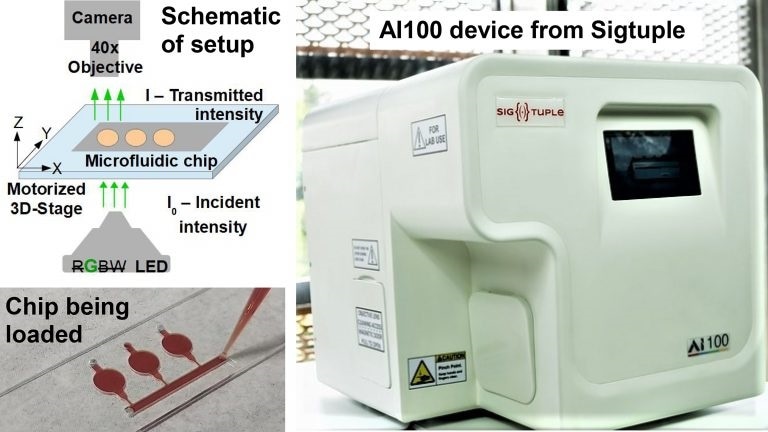The complete blood count is a medical diagnostic test that is often performed to determine the health of patients and generally involves an estimation of the concentration of hemoglobin. Hemoglobin levels in the blood are a crucial biochemical component that can signify various medical conditions, like anemia, pulmonary fibrosis, and polycythemia.

A diagnostic solution to enable simple and cost-effective hemoglobin estimation using a microfluidic chip and AI-powered automated microscope. Image Credit: SigTuple Technologies Pvt. Ltd.
In AIP Publishing’s AIP Advances journal, a research team from SigTuple Technologies and the Indian Institute of Science explained a new AI-powered imaging method to measure hemoglobin concentration. The setup was designed in combination with an AI-powered automated microscope and a microfluidic chip. The microscope was developed to derive both the differential and total blood cell counts.
Medical testing equipment that can handle multiparameter assessments, like hematology analyzers, usually has specialized sub-compartments with individual optical detection devices. This results in increased sample volume and also increases the cost of the whole equipment.
In this study, we demonstrate that the applicability of a system originally designed for the purposes of imaging can be extended towards the performance of biochemical tests without any additional modifications to the hardware unit, thereby retraining the cost and laboratory footprint of the original device.”
Srinivasan Kandaswamy, Study Author, SigTuple Technologies
The hemoglobin test solution is viable due to the design behind a microfluidic chip, optimized imaging, a custom-made biochemical reagent, and an image analysis procedure particularly customized to facilitate the excellent clinical performance of the medical diagnostic test.
The information gathered from the microfluidic chip along with an automatic microscope was similar to the predictions of the hematological analyzers (Pearson correlation of 0.99). Moreover, the validation study demonstrated that the system fulfills regulatory standards, which implies that hospitals and doctors may probably adopt it.
The automatic microscope, which usually uses a mixture of red, green, and blue LEDs, utilized only the green LED at the time of the hemoglobin estimation mode. This is because the light in the green wavelength is absorbed by the optimized reagent (SDS-HB) complex.
Microfluidic, chip-based diagnostic systems are on the brink of transforming the field of health care, and colorimetric biochemical assays are extensively conducted in diagnostic tests.
This paper lays the foundation and will also serve as a guide to future attempts to translate conventional biochemical assays onto a chip, from point of view of both chip design and reagent development.”
Srinivasan Kandaswamy, Study Author, SigTuple Technologies
In addition to estimating hemoglobin levels in the blood, an analogous setup with slight changes could be used for measuring glycated hemoglobin, cholesterol, and protein content.
Source:
Journal reference:
Arcot, L., et al. (2021) Developing microscopy based microfluidic SLS assay for on-chip hemoglobin estimation. AIP Advances. doi.org/10.1063/5.0036446.